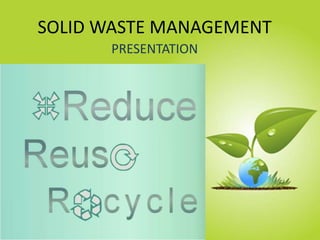
3R cycle(Reduce Reuse Recycle)
- 2. What is 3 R Principle? It is the order of priority of actions to be taken to reduce the amount of waste generated, and to improve overall waste management processes and programs.
- 3. REDUCE Not producing unnecessary waste in the first place— so there’s zero impact on the environment. Why it is needed? •Every product requires natural resources. •To avoid Landfilling(Reduction of methane) •Saves energy •To reduce pollution •It costs your pocket(Rs.1500 to Rs.2000 per Tonne) •An expected 50% increase in the next 10 years
- 4. GENERATION OF WASTE IN INDIAN CITIES CITIES PER CAPITA WASTE(gms) TOTAL WASTE(TONNES) CHENNAI 710 6400 KOLKATA 660 12600 DELHI 650 11600 MUMBAI 510 11650
- 5. How to Reduce waste •Buy only if you need •Avoid overly packaged products •Use durable products •Avoid Non disposable waste •Use reusable products
- 6. Why to reuse? •Because “one man’s thrash is another man’s treasure” •You fulfill someone’s needs •Reusing =Money •It helps in cutting down carbon emissions, greenhouse gases •It prevents world from getting poorer. REUSE Using a potential waste item over & again in its current form without significant processing to alter its structure , is known as reuse
- 7. . How to do it? •Thrift shops •Consignment shops •Material exchange and Reuse centers •Donation drives •Community functions •Repairing,modifying old things
- 8. WHAT TO REUSE ? •Clothes •Furniture •Electronic gadgets •Cars •Rubber products •Batteries •Pen and art supplies •Utensils •Glass products •Bottles •Books •Etc
- 9. Recycle Recycling is the process of making or manufacturing new products from a product that has originally served its purpose
- 10. •for every ton of paper that is recycled, the following are saved: •17 trees •60,000 gallons of water •225 kilowatt hours •3.3 cubic yards of landfill space •Energy used to recycle paper is close to 70% less than when paper is prepared using virgin wood and other raw material. •Almost every hour, nearly 250,000 plastic bottles are dumped. Plastic bottles constitute close to 50% of recyclable waste in the dumps. •The average time taken by plastic bottles to decompose in a landfill is close to 700 years • India recycles roughly 40 percent of their e-waste a year. This includes such items as broken or unwanted electrical appliances. •8,500 mobile phones, 5,500 TVs and 3,000 personal computers are dismantled in Delhi every day for reuse of their component parts and materials. In the capital alone, it is estimated that over 1,50,000 workers are employed in official and unofficial e-recycling units. •One ton of scrap from discarded computers contains more gold than can be produced from 17 tons of gold ore INTERESTING FACTS
- 11. What to recycle? •Tires- •Cartridges- •Electronics •Paper •Foam packing material •Metals •Flourescent bulbs •Motor oil •Construction waste •Ceramics( drainage materials, rock base for driveways or as composite material for aggregates,landfilling) •Paints •Plastic •Glass •Etc
- 12. CONCLUSION the bigger the better, new trumps old and convenience is next to godliness. -By Prathamesh Bagare